
Growing Green Crack Seeds in Canada presents unique challenges, especially when it comes to managing pests organically. Canada’s vast geographic diversity means that pest pressures can vary widely depending on where you’re cultivating. Coastal areas may have more humidity, leading to fungal pests, while inland regions can be prone to drier conditions that attract mites.
Understanding your local environment is key to implementing effective organic pest management strategies. Organic methods are particularly suitable for Canada, as the country has stringent regulations on the use of chemical pesticides in cannabis cultivation. Adopting organic techniques not only keeps your Green Crack plants healthy but also aligns with environmental standards, helping you create a more sustainable grow operation.
In cooler regions, where the growing season may be shorter, pests like aphids and whiteflies can proliferate during warm months. In contrast, warmer areas might struggle with mites or thrips. Regardless of the region, early detection and proactive measures are crucial for ensuring pests don’t damage your Green Crack plants during critical growth stages.
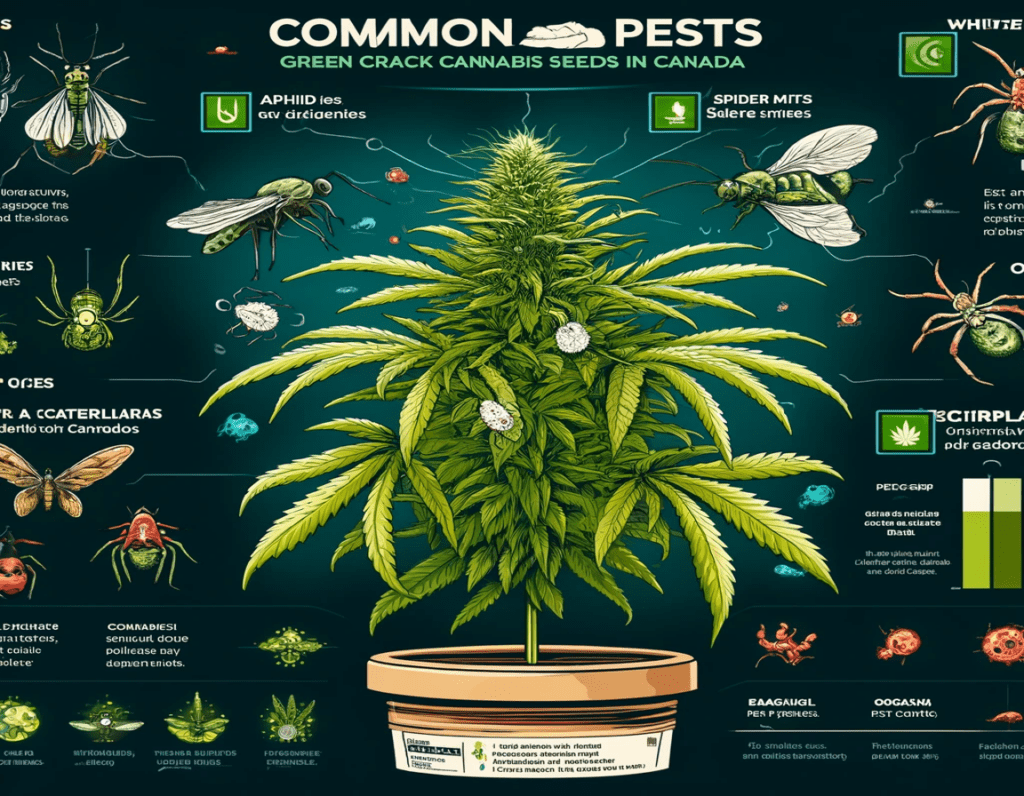
While each region has its own set of pest issues, there are a few common pests that tend to plague Green Crack Seeds across Canada. Identifying these pests early on is critical for effective management:
These tiny insects feed on plant sap, weakening the plant and making it more vulnerable to disease. They’re usually found on the underside of leaves, often forming large colonies.
Particularly common in dry and warm environments, spider mites suck chlorophyll from the leaves, leaving behind small yellow or white speckles.
These pests lay eggs on the undersides of leaves, and their larvae feed on the plant sap, causing stunted growth.
Although they primarily feed on decaying organic matter, their larvae can also damage young roots, weakening seedlings.
Recognizing the damage caused by these pests, such as yellowing leaves or stunted growth, will help you take immediate action and protect your Green Crack crops.
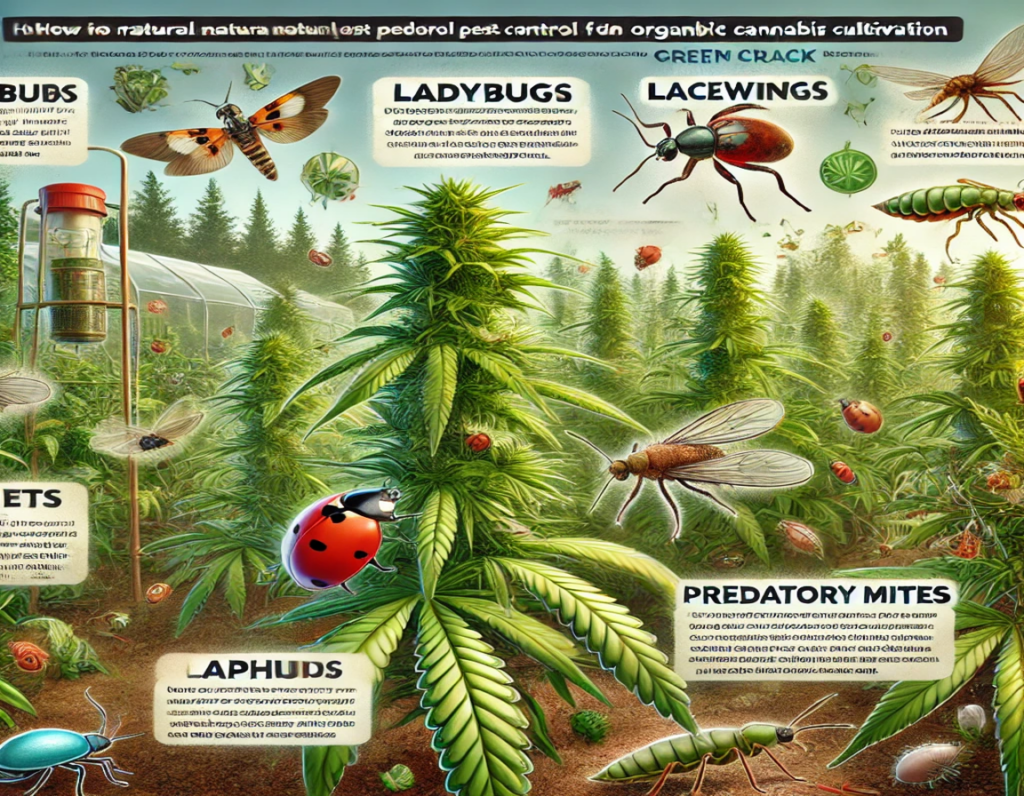
One of the most effective ways to manage pests organically is by introducing natural predators that can help keep pest populations under control. In Canada, the use of beneficial insects like ladybugs, predatory mites, and lacewings is gaining popularity among cannabis growers, including those cultivating Green Crack Seeds.
Known for their voracious appetite for aphids, a single ladybug can consume up to 50 aphids a day. Releasing ladybugs in your grow area can significantly reduce aphid populations.
If spider mites are your primary concern, predatory mites can help. These tiny predators feed on spider mites, preventing infestations from spiraling out of control. In Canadian climates, introducing predatory mites early in the season can prevent larger outbreaks during the warmer months.
These delicate-looking insects are excellent for controlling soft-bodied pests like aphids and thrips. Lacewing larvae, in particular, are efficient at devouring a wide range of pests in their early stages.
Introducing these predators into your garden or greenhouse at the first sign of pests can help prevent infestations before they cause significant damage. It’s essential to monitor the balance between pests and predators to ensure the ecosystem remains in check. For outdoor growers, Canada’s natural environment can also support a healthy population of these beneficial insects without needing to reintroduce them every season.
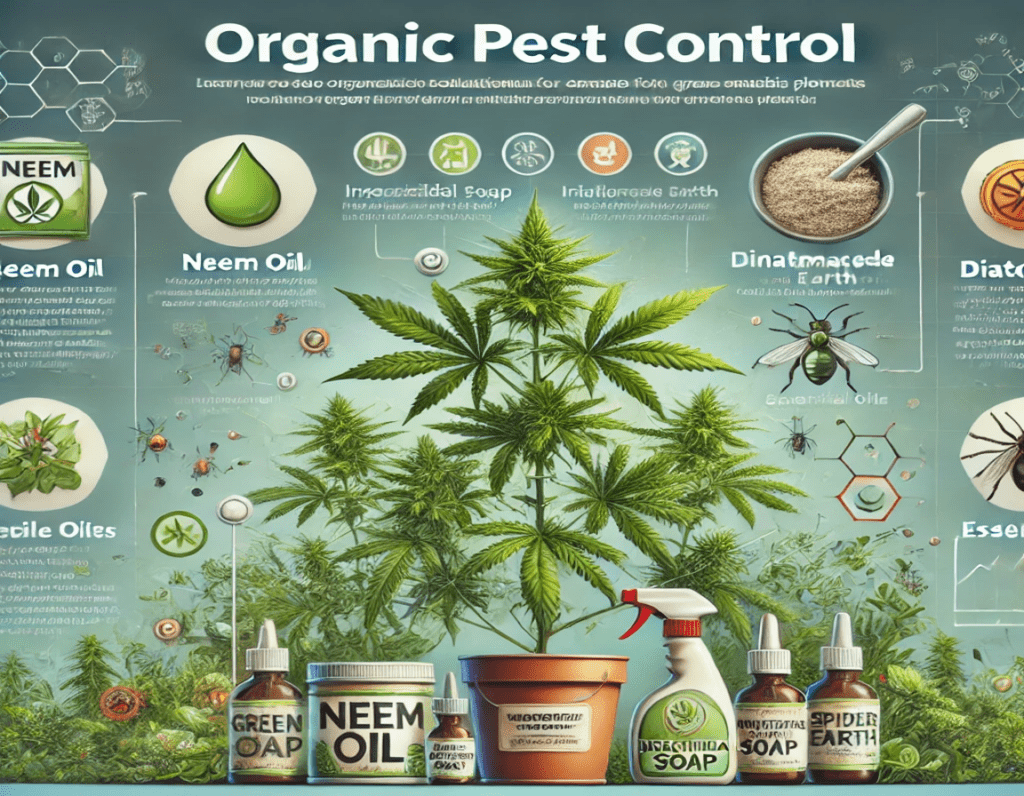
If natural predators aren’t enough or aren’t available in your area, organic pest control solutions are a reliable alternative for protecting your Green Crack Seeds. These solutions range from store-bought organic sprays to DIY remedies made from household ingredients.
One of the most popular organic pest control methods, neem oil acts as both a repellent and a pesticide. It disrupts the hormonal systems of insects, preventing them from feeding or laying eggs. Neem oil is safe to use on Green Crack plants but should be applied during cooler parts of the day to prevent leaf burn.
This soap works by penetrating the insect’s outer shell, causing dehydration and eventual death. It’s especially effective against aphids, whiteflies, and spider mites. Apply insecticidal soap liberally on affected areas, ensuring it reaches the undersides of leaves where pests often hide.
Homemade solutions such as garlic or chili pepper sprays can also be used to deter pests. These pungent ingredients repel pests and can be safely applied to Green Crack plants. Mix garlic or chili with water, strain the solution, and spray it on your plants regularly.
By strategically planting certain herbs and flowers around your Green Crack crop, you can naturally repel pests. Marigolds, basil, and cilantro are known to deter a variety of pests while also adding beneficial nutrients to the soil.
With a combination of these organic solutions, you can maintain a pest-free growing environment without resorting to harmful chemicals.
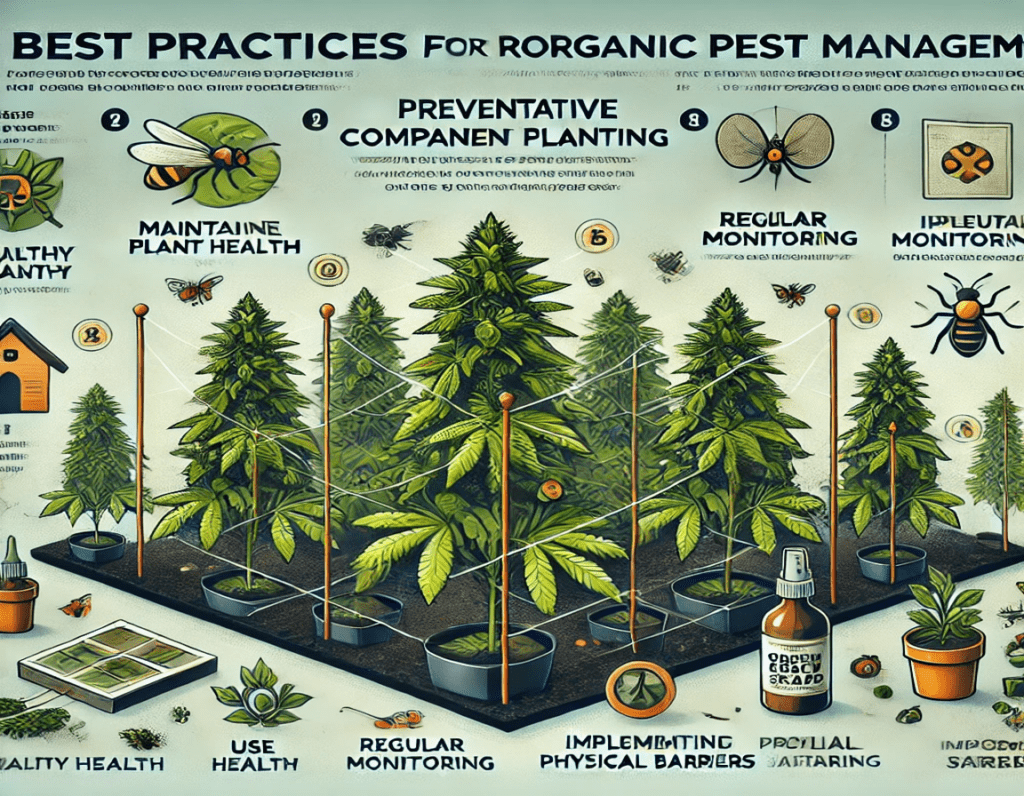
Preventing pests is often more effective and less labor-intensive than eliminating an established infestation. Implementing preventive measures early in the growth cycle can significantly reduce pest problems down the line.
Healthy soil is the foundation of a strong plant. Regularly enriching your soil with compost and organic matter will create a healthier ecosystem that discourages pests. Soil rich in nutrients supports robust plant growth, making your Green Crack plants more resilient to pests.
Alternating where you plant your Green Crack Seeds each season helps disrupt the lifecycle of pests that target specific plants. This is particularly important for outdoor growers in Canada who use the same plot of land year after year.
Applying organic mulch around your plants helps retain moisture and regulate soil temperature, both of which discourage certain pests. Mulch also provides a habitat for beneficial insects, further supporting your organic pest control efforts.
The sooner you spot a pest problem, the easier it is to control. Make it a habit to inspect your Green Crack plants regularly, checking for signs of pests or pest damage. Early intervention can stop an infestation before it becomes unmanageable.
By following these best practices, you’ll create a more sustainable, pest-resistant growing environment for your Green Crack Seeds.
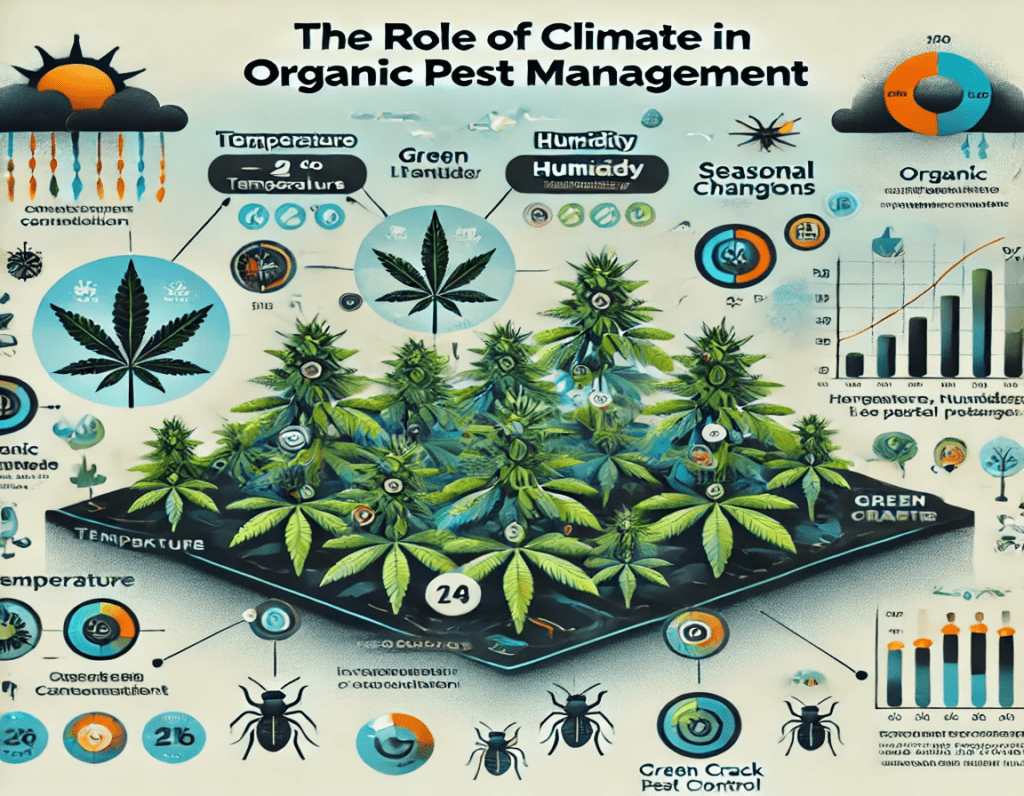
Canada’s climate can vary greatly from one region to another, meaning that the best pest management strategies will depend on your specific location. Understanding how temperature, humidity, and seasonal changes affect pest populations is key to implementing effective organic pest control methods.
In regions like British Columbia, where humidity levels are often higher, fungal pests and insects that thrive in damp conditions, like fungus gnats, can be a major issue. Controlling humidity levels in your growing environment can help reduce the risk of these pests. For outdoor growers, ensuring proper drainage and spacing between plants can help minimize humidity-related problems.
In warmer areas, pests like spider mites and thrips can become problematic during the hottest parts of the growing season. For indoor growers, controlling the temperature through ventilation and climate control systems is essential to reducing these pest populations. Outdoor growers may need to adjust watering schedules to prevent heat stress, which can attract pests.
The growing season in Canada can be relatively short, depending on the region. As temperatures drop in the fall, pests like aphids may become more active, seeking out plants to feed on before winter. Applying organic pest control methods during late summer and early fall can help manage these end-of-season pests.
Different climates require different pest control strategies. In colder regions, you may have a shorter window for pest activity but should be prepared for a spike during the warmer months. In contrast, warmer or more humid areas may require year-round vigilance. Tailoring your organic pest management practices to your region’s climate will ensure the best results.
Common pests include aphids, spider mites, whiteflies, and fungus gnats, depending on the climate and growing conditions.
Yes, but their effectiveness can vary based on the local environment. For instance, predatory mites work well in warmer regions, while ladybugs thrive in most areas.
Yes, neem oil is safe to use, but it’s best applied during cooler parts of the day and avoided in the flowering stage to prevent residue on buds.
Insecticidal soap can be applied every 5-7 days until pests are under control. Be sure to cover all areas of the plant, especially the undersides of leaves.
Marigolds, basil, cilantro, and garlic are excellent companion plants for deterring pests while enhancing the health of your Green Crack plants.
We ship and deliver world wide via USPS and various couriers.
We offer a wide range of secure and anonymous online payment options.
We care about you, our customer. Please contact us with any questions or concerns.
Find out more about the benefits of being a loyal and regular customer.
WE ARE EVERY GROWERS ONE STOP SHOP TO ACQUIRE PREMIUM CANNABIS SEEDS FOR SALE IN THE USA, CANADA AND AUSTRALIA

Farmers Lab Seeds 2024, | All Right Reserved
Seeds are sold as novelty items, souvenirs, and collectibles. They contain 0% THC. We encourage our customers to check the legislation in their Country, State, Province, and Municipality prior to purchasing items from our store. We do not provide growing information.
All seeds are sold as hemp, and lab tested under 0.3% THC. This product is not for use by or sale to persons under the age of 21. This product should be used only as directed on the label. It should not be used if you are pregnant or nursing. Consult with a physician before use if you have a serious medical condition or use prescription medications. A Doctor’s advice should be sought before using this and any supplemental dietary product. All trademarks and copyrights are property of their respective owners and are not affiliated with nor do they endorse this product.
These statements have not been evaluated by the FDA. This product is not intended to diagnose, treat, cure or prevent any disease. Individual weight loss results will vary. By using this site, you agree to follow the Privacy Policy and all Terms & Conditions printed on this site. Void Where Prohibited by Law.